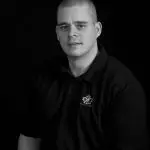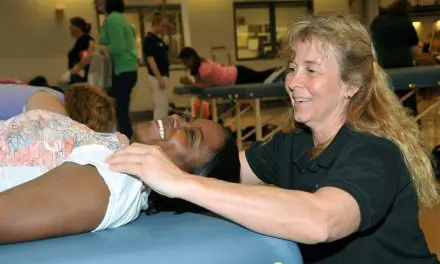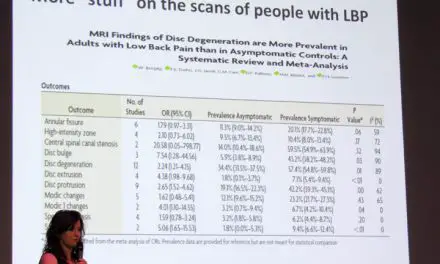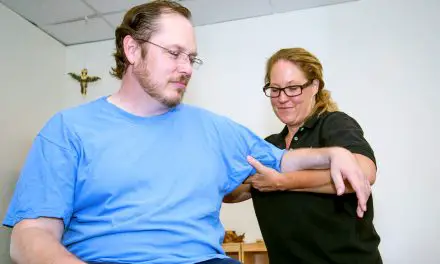It was time for a career change — or rather a career improvement. There was an opportunity to become a first-aid attendant at a sawmill I used to work at, so I took two weeks off dove into the course. It was intense and I was learning to do things I never thought I would actually do to a person. Then, I got the job and the real learning started.
Imagine being responsible for 150 people per shift in a huge industrial place where machines can take a tree and pound it into sawdust. That thought scared the crap out of me. I had no idea if I’d be able to handle the situations I would get thrown into. But one of the senior first aid guys gave me a great piece of advice: “You gotta learn somewhere, so it might as well be here.”
Everyday I was dealing with everything from minor cuts and bruises to major head injuries, strokes, and a host of other medical conditions. A year later I joined the local volunteer fire department and started to respond to even more emergencies, joined a ski patrol at our local mountain, and I was pretty much immersed in emergency response. In 2008, the mill shut down and I went back to school to be a registered massage therapist (RMT).
However, I never quit the fire department. I just joined the volunteer hall in the community I moved to when I went to massage college. In 2011, I was hired as a fire dispatcher. So now my life is massage, fire, dispatching and teaching first aid and sport first responder to other RMT’s.
A Change in RMT Standards
Back in 2014 our provincial regulatory college made it mandatory for RMTs in British Columbia to become certified in first aid. I think I was the only one who applauded the idea. There was a massive uproar and therapists were angry, and I couldn’t understand why.
Why would you not want to help someone who is having a medical emergency? Then it dawned on me: it’s scary and it’s more responsibility.
After 16 years of doing this stuff and responding to medical emergencies on a weekly basis, sometimes it still freaks me out! And that is with regular practice! The average first aid certification lasts three years, and in that three years, there is a good chance you will never use it. So when something does happen three, five, six years down the road, I understand how it could be an emotional and unnerving situation.
However when we look at the standards in our profession, there is a requirement to do an appropriate intake of a patient, look at their health history and do a proper assessment. When I teach a first aid course, we review different medical conditions, such as diabetes, asthma, angina, anaphylaxis, and a host of other conditions. As we review each condition, I ask if anyone knows someone who deals with the above conditions and inevitably a good portion of the room puts up their hand.
How many of you have a patient that has diabetes, angina, asthma or any other medical condition and have seen at least one of them on an intake form? While I realize this change in standard was in our province and not applicable globally, shouldn’t it be? As we work to push our industry forward, isn’t being prepared for a medical emergency not just sensible but also the right thing to do?
I don’t know how many medical calls or issues I’ve dealt with over the years, but let’s just say it’s a lot. Sadly, not all of them are successful. For the first time ever back in 2015, our crew (with the help of others) successfully resuscitated someone using CPR and AED.
We were shocked! It was the first time we had seen this happen. One of the big reasons we were able to bring him back was because his wife and other bystanders started CPR right away. We are usually too far from the scene for a successful outcome.
If someone suffered a cardiac arrest in your clinic and you see it happen, you have a much greater chance (and quite frankly responsibility) to bring the person back if you know how to do CPR. If the patient had to wait for first responders to arrive before anything is done, their chances of survival diminish by the minute.
For every scene I’ve been to where there is an unsuccessful outcome, there is usually a team of eight or nine responders and paramedics working on a person. While this is happening, the family members are given peace of mind. They are able to leave the room, mourn, and spend time with each other. They have the relief that there is a team doing everything they can to work on their mom, dad, son, daughter, sister, loved one, or whoever it happens to be.
So, what if this was one of your patients or clients?
If your practice is anything like mine, there are people I’ve been treating for years: family members, parents who bring their kids, kids who refer their grandparents. What if any one of them had a medical emergency on your table? Or what if it was one of your loved ones who had an emergency on another therapists table?
Would you not want the peace of mind knowing that every effort was made to help them?
As we push to advance our profession, we want to become known worldwide as healthcare professionals. Part of being a healthcare professional is holding ourselves to a higher standard than what the public perceives. Someone recently sent me a message saying we are treading a slippery slope in the profession if we want to start treating emergencies. If we truly want to be regarded as healthcare professionals, it’s our responsibility to be able to manage what is happening with our patients in our clinic. I think we are treading a slippery slope if we don’t know how to manage this, not just as a therapist, but as a person helping another human.

Jamie Johnston, RMT
Throughout his career in Victoria, British Columbia, Jamie has been working in a clinical setting as well in various on-site sport settings. He has been able to take his knowledge from being a volunteer firefighter and former industrial first-aid attendant into application as a massage therapist by teaching other therapists how to handle medical emergencies within a clinical setting.
In 2015, he launched Massage Therapist Development Centre, a collaborative blog about manual therapy to help raise awareness about the awesome things massage therapy and massage therapists do.




